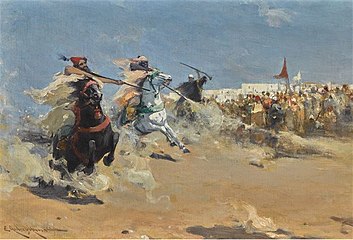Edmund Aubrey Hunt

Edmund Aubrey Hunt (17 February 1855, in
Biography
His father was the entrepreneur and inventor, Edmund Soper Hunt, who operated a fireworks factory, made ladies' fans, and devised improvements to the line-throwing cannon, used in marine rescue operations.
After graduating from college, he entered the prominent architectural firm of
The newlywed couple moved to London, where he had recently held several exhibits. He frequently took paintings back to the United States, where they were exhibited at galleries in Boston. His local venues included the
His marriage to Agnes ended in the late 1880s, and their four children went with her, but he met another Englishwoman, the well-to-do Maude Chadwick, during a trip to North Africa, and they were married in 1892. Both admirers of the area, they settled in Tangier, where they lived for ten years. He perfected his Orientalist paintings there, and became an acquaintance of the local ruler.
After the birth of a daughter, they returned to England and settled in
Selected paintings
-
The Last Ship Up, in Greenwich
-
Arab Fantasia
-
View of Notre Dame
References
- ^ Biography @ the University of Glasgow
- ^ a b c Suffolk Artists
Further reading
- Edmund Soper Hunt, Weymouth Ways and Weymouth People, privately published, 1907. Reprinted, Nabu Press, 2010 ISBN 978-1-1778-7417-5
External links
- More works by Hunt @ ArtNet
- More works by Hunt @ ArtUK




